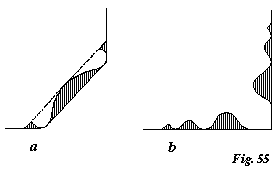316 THE STONES OF VENICE DECORATION
chamfer d, Fig. 53, is large, it is impossible to say whether they have been derived from the incised angle, or from small shafts set in a nook, as at e, Fig. 54, or in the hollow of the curved chamfer, as d, Fig. 54. In general, however, the shallow chamfers, a, b, e, and f, Fig. 53, are peculiar to Southern work; and may be assumed to have been derived from the incised angle, while the deep chamfers, c, d, g, h, are characteristic of Northern work, and may be partly derived or imitated from the angle shaft; while, with the usual extravagance of the Northern architects, they are cut deeper and deeper until we arrive at the condition f, Fig. 54, which is the favourite chamfer at Bourges and Bayeux, and in other good French work.
I have placed in the Appendix* a figure belonging to this subject, but which cannot interest the general reader, showing the number of possible chamfers with a roll moulding of given size.
§ 13. If we take the plain chamfer, b, of Fig. 52, on a large scale, as at a, Fig. 55, 
§ 14. Many other mouldings, which at first sight appear very elaborate, are nothing more than a chamfer, with a series of small echoes of it on each side, dying away with a ripple on the surface of the wall, as in b, Fig. 55, from Coutances: (observe, here the white part is the solid stone, the shade is cut away).
* Appendix 23: “Varieties of Chamfer” [p. 469].
[Version 0.04: March 2008]